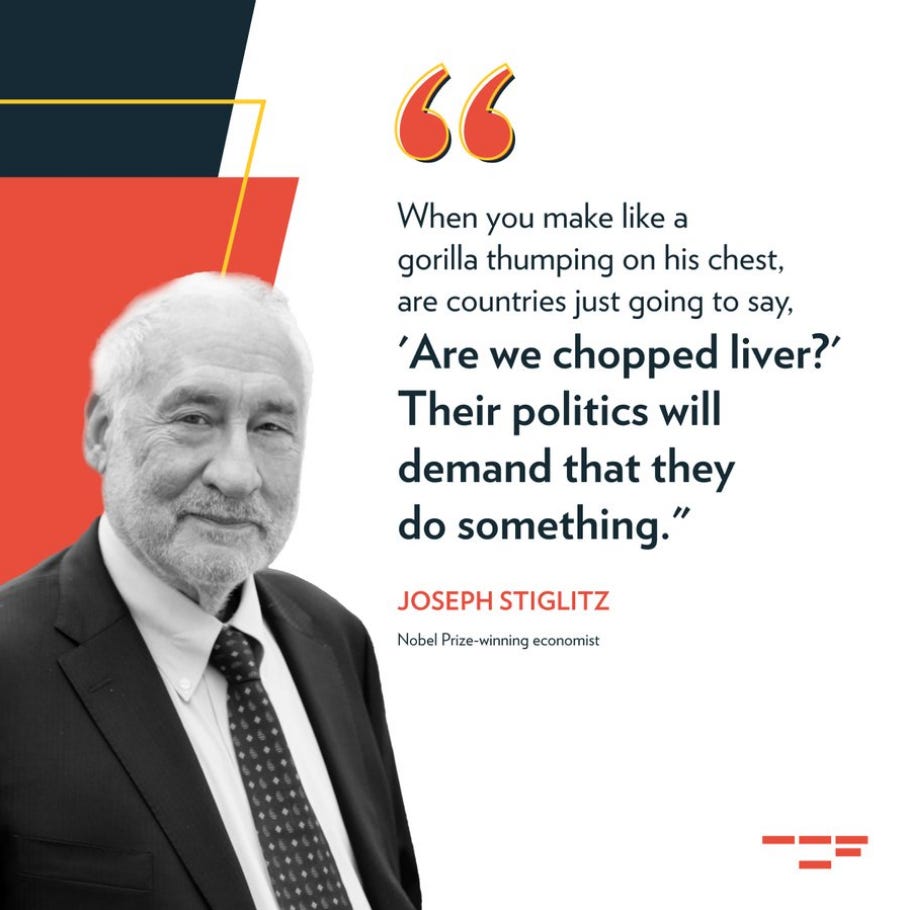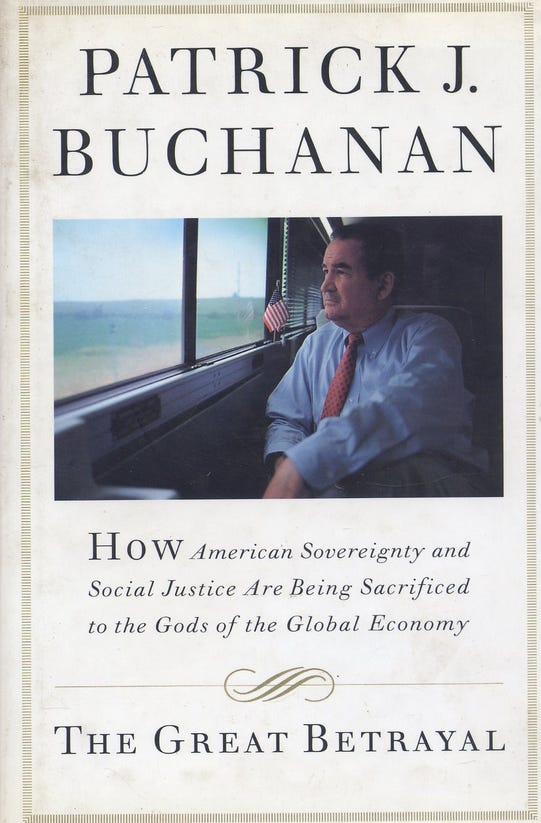President Trump’s aggressive tariff policies mark a shift in trade policy, but must be paired with strong reindustrialization.
President Donald Trump has made it clear that tariffs will continue to be a major tool for his economic agenda.

Trump’s first term (2017–2021) and second term (so far) have been characterized by aggressive use of tariffs to reshape global trade relationships, protect domestic industries, and address perceived trade imbalances.
Prior to Trump being elected, the prevailing assumption among neoliberal and libertarian economists was that tariffs were a backward form of taxation on imported goods and services. The argument is that tariffs raise the cost of imported goods, which businesses often pass on to consumers in the form of higher prices. Notably, Nobel laureate Joseph Stiglitz argued that tariffs reduce GDP growth and employment while increasing inflation.

Pro-free market economists generally view tariffs as anathema to their agenda of unrestricted trade across borders. Moreover, they argue that the imposition of tariffs is a harbinger for economic instability.
However, the historical record shows that tariffs have been part of American economic policy throughout the nation’s first 150 years without generating any major economic crises. The Hamilton Tariff of 1789 was one of the first major laws passed by Congress, designed to generate revenue and protect American industries. Customs duties were easy to implement. They were collected at ports on imported goods, and provided a reliable income for the government. Tariffs accounted for 80–95 percent of federal revenue during the period of 1789 to 1862.
Things changed during the Civil War era (1861-1865) when the government turned to excise taxes and income taxes to supplement tariff revenues due to increased wartime expenditures. By 1865, excise taxes made up 63 percent of federal revenue, surpassing tariffs. Once the war concluded, tariffs returned as a major revenue source, contributing 49 percent of federal income between 1863 and 1913.
In that time-frame, the United States went from an agrarian yeoman republic to the world’s premier industrial power. The United States reached its highest average tariff rates in 1870 at 44.6 percent on dutiable imports, while the peak tariff rates on specific goods soared to 61.7 percent under the 1828 “Tariff of Abominations” and 59.1 percent under the 1930 Smoot-Hawley Tariff Act. In almost all these cases, the U.S. economy hummed along without major issues.
Proponents of tariff reduction argue that the Smoot-Hawley tariffs played a major role in fueling the Great Depression. However, as economists like Murray Rothbard have shown, this analysis oversimplifies a complex economic crisis that was largely caused by government and Federal Reserve intervention—in the form of artificially low interest rates—rather than tariff policy.
Though after World War I, and especially in the wake of World War II, the United States gravitated toward a liberal internationalist set of policies, with free trade being an integral component of this agenda.

This free trade regime began in earnest in 1947 with the signing of the General Agreement on Tariffs and Trade (GATT). Since then, the U.S. has aggressively reduced tariffs, culminating in an average Most Favored Nation (MFN) tariff rate of just 3.4 percent by 2021.
This free trade order was overturned when Donald Trump was elected in 2016. Wasting no time, Trump immediately imposed a 25 percent tariff on steel and 10 percent tariff on aluminum imports under Section 232 of the Trade Expansion Act.
During the first phase of the United States’ trade war against China in July 2018, Trump slapped a 25 percent tariff on $34 billion worth of Chinese goods. The second phase of the trade war broadened the tariffs to $16 billion in Chinese imports. Furthermore, the third phase of the trade war saw 10 percent tariffs applied to $200 billion worth of imports, which were subsequently raised again to 25 percent. By the end of 2019, tariffs covered over $360 billion worth of Chinese goods.
Trump is continuing this kind of economically-protectionist policy-making during his second term as witnessed by his move to raise baseline tariffs to 20 percent across all Chinese imports in February 2025, up from the previous average of 10 percent. In a similar vein, he increased steel tariffs to 30 percent and aluminum tariffs to 20 percent, citing ongoing national security concerns.
Protectionist policies were also extended to key trade partners such as Canada and Mexico, who both saw 25 percent tariffs on most of their imports. All told, the average U.S. tariff rate on all imports rose from 2.4 percent in 2023 to approximately 10.5 percent in March 2025, marking one of the largest increases in U.S. history. Trump is correct in imposing tariffs to protect U.S. industry from countries that engage in suspicious trade practices that undercut U.S. labor and enterprises. In an ideal world—one in which the administrative state is greatly reduced, and federal spending is contained—tariffs could replace the income tax and other federal taxes as the primary form of taxation at the federal level.
That said, tariffs alone will not revitalize American industry and reverse the effects of multiple decades of deindustrialization. Economists like Michael Hudson argue that tariffs alone cannot achieve industrial revitalization without a broader industrial strategy. There ultimately needs to be complementary policies such as state investment in infrastructure or controls on speculative finance.
The U.S. must get serious about taming its overly financialized economy, wherein corporate profits are channeled into speculation rather than productive investment. In such an environment, tariffs cannot effectively reindustrialize the economy because capital is not directed toward manufacturing or innovation.
Moreover, the United States must be prepared to carry out large-scale government spending on infrastructure projects. As WPPI previously noted, public-partnerships should be forged at both the national and state levels to foster industrialization. That means the government should actively support strategic industries through subsidies, tariffs (when necessary), research funding, and the establishment of sovereign wealth funds specifically targeting the scale-up phase of manufacturing.
Decades of offshoring has resulted in a significant manufacturing skills gap. This necessitates structured workforce training programs. Initiatives such as Wisconsin’s Department of Workforce Development grant, which successfully reduced employee turnover from nearly 100 percent to approximately 15 percent, exemplify the potential of targeted training investments.
To systematically address this skills gap, collaborative efforts among state institutions, labor unions, community colleges, and the private sector are essential. Establishing a nationwide network of tailored training programs will equip American workers with the requisite manufacturing skills to jump-start previously hollowed out sectors of the economy while aligning closely with industry demands.
There are no silver bullets in the quest to restore America’s prowess as a manufacturing juggernaut. Tariffs will undoubtedly play a role in this process. Nonetheless, this must be combined with a robust industrial policy that plugs in the many holes globalization has poked in the U.S. economy.
Reindustrialization will not be a walk in the park but it’s a venture worth fighting for. The United States can’t truly be sovereign if its economy does not truly serve the nation.
